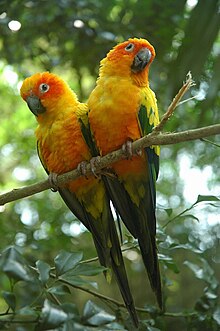Aratinga solstitialis
| Sun parakeet | |
|---|---|
 |
|
| Scientific classification | |
| Kingdom: | Animalia |
| Phylum: | Chordata |
| Class: | Aves |
| Order: | Psittaciformes |
| Superfamily: | Psittacoidea |
| Family: | Psittacidae |
| Subfamily: | Arinae |
| Tribe: | Arini |
| Genus: | Aratinga |
| Species: | A. solstitialis |
| Binomial name | |
|
Aratinga solstitialis (Linnaeus, 1758) |
|
The sun parakeet or sun conure (Aratinga solstitialis) is a medium-sized brightly colored parrot native to northeastern South America. The adult male and female are similar in appearance, with predominantly golden-yellow plumage and orange-flushed underparts and face. Sun conures are very social birds, typically living in flocks. They form monogamous pairs for reproduction and nest in palm cavities in the tropics. Sun conures mainly feed on fruits, flowers, berries, blossoms, seeds, nuts and insects. Conures are commonly bred and kept in aviculture and may live up to 30 years. This species is currently threatened by loss of habitat and trapping for plumage or the pet trade. Sun conures are now listed as endangered by the IUCN.
The sun parakeet was one of the many species originally described by Linnaeus in his 18th-century work Systema Naturae. As Linnaeus did with many of the parrots he described, he placed this species in the genus Psittacus, but it has since been moved to the widely accepted Aratinga, which contains a number of similar New World species, while Psittacus is now restricted to the type species, the African grey parrot. The specific epithet solstitialis is derived from the Latin for 'of the summer solstice', hence 'sunny', and refers to its golden plumage. There are two widely used common names: Sun Conure, used in aviculture and by some authorities such as Thomas Arndt, and Sun Parakeet as used by the AOU and widely in official birdlists, field guides, and by birders.
The sun parakeet is monotypic, but the Aratinga solstitialis complex includes three additional species from Brazil: jandaya parakeet, golden-capped parakeet, and sulphur-breasted parakeet. These have all been considered subspecies of the sun parakeet, but most recent authorities maintain their status as separate species. Alternatively, it has been suggested that the sun parakeet and the sulphur-breasted parakeet represent one species, while the jenday parakeet and golden-capped parakeet represent a second. Of these, the sulphur-breasted parakeet only received widespread recognition in 2005, having gone unnoticed at least partially due to its resemblance to certain pre-adult plumages of the sun parakeet. The sun, jandaya, and golden-capped parakeets will all interbreed in captivity (it is likely, but unconfirmed, that the Sulphur-breasted also will interbreed with these). In the wild, hybrids between the jandaya parakeet and golden-capped parakeet have been reported in their limited area of contact, but it has been speculated that most such individuals could be sub-adults (which easily could be confused with hybrids). As far as known, the remaining taxa are entirely allopatric, although it is possible that the sun parakeet and the sulphur-breasted parakeet come into contact in the southern Guianas, where some doubts exists over the exact identity.
...
Wikipedia

